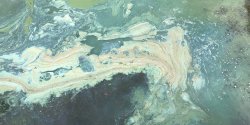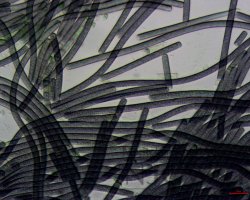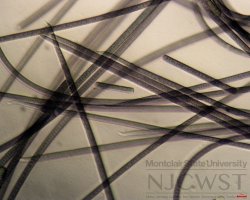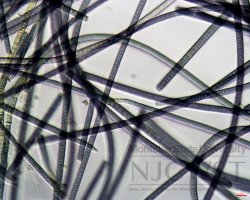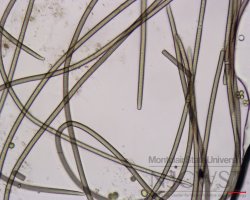Taxonomy
- Order
- Oscillatoriales
- Family
- Oscillatoriaceae
- Genus
- Phormidium
Examples of Phormidium
The genus Phormidium has undergone considerable revision, including a reclassifications of some species into various other genera, and there are taxonomic questions that have yet to be answered (Komárek et al. 2014). The number of accepted (taxonomically valid) species may not be consistent from one source to another: upwards of 200 species, according to Komárek et al. (2008); “nearly 20-30” species, according to Johansen & Komárek (2015); 207 accepted species, according to Phormidium’s AlgaeBase profile, most recently edited in 2018 (Komárek & Guiry). The sources consulted in writing the morphological and ecological profiles below are Komárek et al. (2008) and Johansen & Komárek (2015).
Morphology
Filaments usually in expanded thallus, growing attached to substrate (secondarily floating in masses); texture varies (from thin to thick, fine to leathery). Filaments sometimes form tufts or clusters, and are rarely solitary. Filaments without any branching; slightly waved to loosely, irregularly coiled. Sheaths may occur facultatively to almost obligately, depending on environmental conditions. Trichomes are cylindrical, sometimes narrowed very near to the ends; mostly long; 5-11(15) μm wide; unconstricted or constricted at crosswalls; conspicuously motile. Cells distinctly shorter than wide (Johansen & Komárek, 2015); or isodiametric to longer than wide (Komárek et al, 2008); cells lack aerotopes. End cells rounded (Johansen & Komárek, 2015); or pointed or narrowed (Komárek et al. 2008); sometimes with a calyptra.
Ecology
Mat-forming in a variety of habitats (on wet soil, mud, damp rocks, aquatic plants; in various waters; hot springs; desert soil). Common and found worldwide.
References
- Johansen, J. R., & Komárek, J. (2015). Filamentous Cyanobacteria. In J. D. Wehr, R. G. Sheath, & J. P. Kociolek (Eds.), Freshwater Algae of North America: Ecology and Classification (2nd ed., pp. 162-181). Waltham, MA: Elsevier.
- Komárek, J. & Anagnostidis, K. (2008). Cyanoprokaryota-2. Teil/Part 2: Oscillatoriales. In B. Büdel, G. Gärtner, L. Krienitz, & M. Schagerl (Eds.), Süßwasserflora von Mitteleuropa (Vol. 19/2, pp. 390-391). Heidelberg, Germany: Spektrum.
- Komárek, J., & Guiry, M. D. (2018, March 12). Phormidium Kützing ex Gomont, 1892. AlgaeBase. https://www.algaebase.org/search/genus/detail/?genus_id=43079.
- Komárek, J., Kaštovský J., Mareš J., & Johansen J. R. (2014). Taxonomic classification of cyanoprokaryotes (cyanobacterial genera) 2014, using a polyphasic approach. Preslia 86: 295–335.
